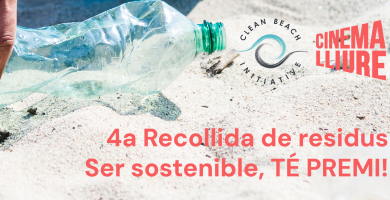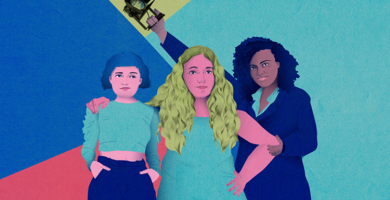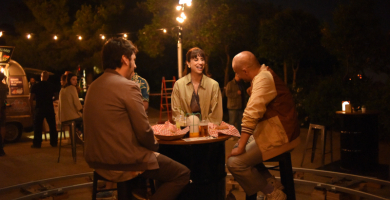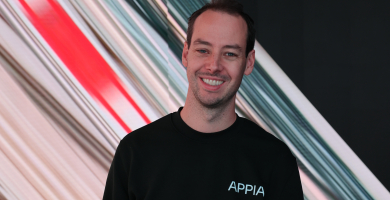
ANTOINE VAXELAIRE: "I’m absolutely convinced that Barcelona is an ideal city for a studio of this type."
This month we interviewed Antoine Vaxelaire, co-founder and creative director of Plató Nou, a new studio located in the centre of Barcelona which arose from the collaboration of the companies Appia and Lavinia.

You are an architect. In principle, virtual studios don’t seem to have much to do with architecture. How did you join this world?
Through my partner in the company, Patrick Morris, who’s also an architect. Together we founded Appia in 2019. I was working as an architect but, after studying architecture, Patrick went directly into doing lightshows for concerts, festivals, etc. To do these lightshows, you have to work with a specific machine which is the same machine and the same company that had entered virtual production some time ago. So Patrick discovered virtual production. He was working with this company which was inventing the technology. He saw it a little before most people and that’s why he called me. He asked me “what do you think if we tried it?” I was looking for a change of professional life and we worked on it in secret for six months, before launching and opening the first studio in Switzerland at the beginning of 2020.
Is virtual production a very well-known technology in the audiovisual sector?
It depends a lot on the country and I’d even say on the city. Some cities were undoubtedly pioneers. Obviously, Hollywood began very early but that’s a market that I’ve never touched, and I don’t want to touch. It’s far away and it has its own things. But it’s clear that they started it. In Europe, London was also the first city to get into this very quickly with a studio called Mars. From there they began to do a lot of things and to expand. Then it jumped to Paris, which I think would now be one of the most powerful cities in Europe. And then all the others. I’m referring to Barcelona, Madrid, Geneva and Brussels, which I’d say have had this technology for more or less two years. There’s a lack of knowledge. There’s still a lot of work to be done to make it well-known. And even more work for it to expand and for the industry itself to be able to use it. One thing is having seen two videos on YouTube; I know it exists and I know its name but it’s something else to come and suffer in the world of these studios. And that’s our job. In actual fact, my job is just that.
What does it consist of exactly?
In Appia there are six of us. Of these six, three are 100% technicians capable of operating these studios, assembling them, connecting the cables, starting them up and operating the machines. With three technicians a studio like this works well whatever its size. Then we have two people who are responsible for 100% of the creation of the content that appears on screens. And then there’s me. My profile isn’t at all technical; it’s explanatory and educational. I’m in charge of ensuring that when people come we’re capable of explaining this technology in the best possible way. Doing demos or holding meetings. Calling, explaining, understanding the needs of the industry and seeing whether we have an appropriate response. Part of my work is explaining from minute one that this isn’t an absolute solution to all the world’s production problems. It’s a very good solution to some very specific problems.
Why did you choose Barcelona for this studio?
Plató Nou is a specific project of Appia. It’s our third project. We’re devoted to setting up studios, always in collaboration with another company. We’ve done it like that in Switzerland and Paris. And since June in Barcelona with Lavinia. There’s a dual reason. One is personal; I’ve been living in Barcelona for seven years and I didn’t want to travel any more. This reason gave me the energy to launch the project. But the professional reason is that I’m absolutely convinced that Barcelona is an ideal city for a studio of this type. And that’s not just me talking. The industry in Barcelona and Catalonia is very good; it always has been. They’ve been filming high-quality ads for many decades and these studios are perfect for this type of shoot. I think I’ve been lucky enough to live somewhere where I believe that there’s a very good production industry, for fiction, advertising and other things.
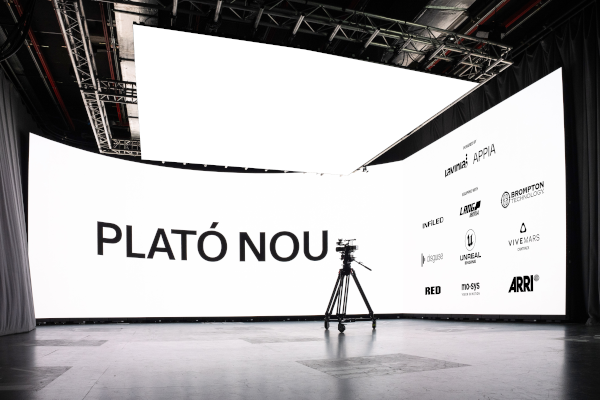
What does Plató Nou offer?
Basically it’s a permanent virtual production studio. Many of these studios are assembled and disassembled for a specific project. They’re not permanent. That’s the formula of Netflix in Madrid, for example. It’s very good for them because they have huge studios, and huge budgets which allow them to do this. It’s very good for their formula. We’ve always wanted to have permanent studios because they allow us two things: first, to drastically reduce costs and give many projects access to this technology, not just the top projects. For Appia this has always been very important. Second, our team consists of employees; they’re not freelancers who come to record and then go. They can learn, because we have to train them and investigate. Whenever there isn’t a shoot, the team is investigating the technology. And this is a job that we have to do, because it’s a very young technology which is in its infancy. It’s been in its current state for a maximum of five or six years and therefore you need to work on it every day, because it’s not yet stable; there are flaws, and the team has to be comfortable with this technology. Another advantage is that it’s in the centre of Barcelona. And there we have a strength because the partnership with Lavinia allows us to offer all the services that exist around production. The idea is to help the productions which come to see us as much as possible. With the creation of content which we do. With preproduction and postproduction services which we can also do.
What are the advantages of virtual studios?
The main advantage, as I mentioned, is for very specific cases. We need to talk about specific examples. There isn’t an absolute, general advantage. I wish that was the case, but it’s not. One specific example is shoots with cars. That’s the best example in films which have been produced in virtual studios. They’re almost all done like that now because it allows you to record cars which are moving without starting a single car. We only have to position the vehicle in front of the screens and then make the content move. And with this we can pretend that the car is moving anywhere in the world at any speed. The actors do their usual work in the car, acting, and this comes out very well in the final image that the audience sees. There’s very little postproduction. That’s the huge advantage: drastically reducing the quantity of postproduction that’s always been long and expensive.
Then there are other advantages. We did projects during COVID. You couldn’t travel but you could come here. It’s a very specific case, but obviously because of budget restrictions many productions can’t go where they’d like to. We did a project that had to be in Iceland. We created a copy of Iceland on the LED screens and the actress was able to pretend she was there. The main advantage is very pragmatic; it allows producers to go where they can’t go, whether the location is real or fictional, near or far. If for several reasons we can’t go, such as issues to do with permits, budgets, pandemics, etc. I think that’s the main advantage of the studio: to give access to inaccessible places.
Can the productions come with their own regular equipment or do they need specific material to shoot in these studios?
We are an element added to the usual production work. Without changing what they need. They come with their traditional technical equipment and the technology they already know: camera, lights or whatever. And we join their existing ecosystem. The only thing they have to know is that with their camera they’re going to record already on a screen and this has a series of consequences, which we call artefacts. Because the camera has very sensitive sensors and begins to see things because it’s recording another technological element. It doesn’t change what they come with: people or equipment, but it will change when it comes to recording. That’s why, in preproduction, we always invite the key people like the director, the director of photography and the DIT (digital imaging technician) to attend information sessions with us where we can tell them “be careful, if you record with this camera, this lens with this type of content you might have a moiré-type artefact”. Apart from that, the only thing is that to record on a LED screen the camera has to have genlock (generator locking). It would be very complicated to record with a camera which hasn’t got this. It’s like the heartbeat of our entire system. Our body gives a rhythm to all the organs and everything depends on that. It’s exactly the same on a digital level. It sends a pulse every so often and all the machines follow the same pulse, and this ensures that everything works well. If there is latency in this, and that happens when the camera doesn’t have this genlock, we have more problems. But it can be added to any camera.
If we want to film with real images of Barcelona to then be able to use them on the screens of a virtual studio, is it a very complicated process or is it easy?
It’s easy and it’s not new. Even Hitchcock did it. We’ve all seen those visual effects that we like now, but that weren’t very high quality. A car which moves with rear projection on the windows. It’s exactly the same logic. At some point in time, someone has to go and record the street that we want. The advantage is that, nowadays, a single person goes with a car. We did it recently for a series. They went to record with a Smart with five cinema cameras set up. They go to the street, record what the production company asks for, send us the videos, we put them in our computer and project them on the screens. It’s a long process, because the files are very heavy, but I’m talking about a couple of hours. It’s not a question of days. It’s not extremely complex.
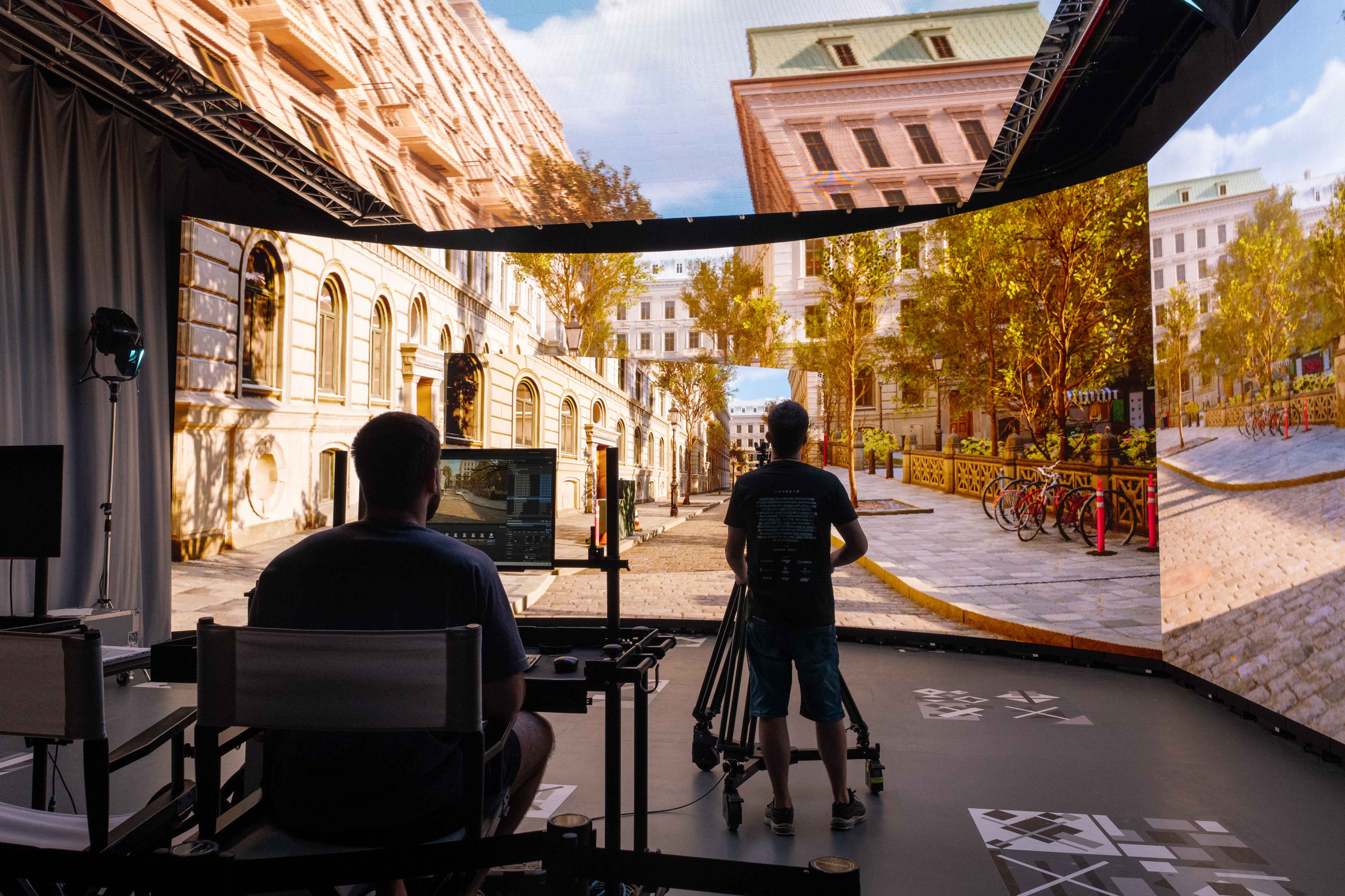
With a virtual studio you can create the world that you want in a realistic manner, from a landscape in Vietnam to a street in Paris, etc. Even effects like explosions, snow, rain, etc.
There are always two types of contents. Recording the real world which we project on the screen or creating 100% digital worlds from scratch. That’s the first question I ask the projects that come here. What do you want? Real things, a digital copy of something real or something fictional? In the Iceland project it would have been possible to send someone there with a camera, but we preferred to create Iceland on our computers, basically to have greater control. The difference between the two is that if we record in the real world and project it on the screens, we don’t have control over this content. You already recorded it with a precise FPS, with a camera and at a specific speed, at a certain time of the day. It’s high-quality content, but you can’t make changes. In the other 100% digital field, that’s where its strength lies. You don’t achieve the same realism, but there’s absolute control over everything you see. Each production company has to assess what they’re more interested in, realism or control.
Can you explain in a simple way what technology virtual production uses? What you call the magic triptych.
We invented this very basic concept in which virtual production can be summarized as a magic triptych with three fundamental components. The first is the LED screen, which is the most visible part. The second part is the computers. We need very powerful machines for the content that we project on the LED screens to work well. They are very high resolution, due to the size of the screen. And the third part of the triptych is a camera tracker. This is very important. Any production company can come with any cinema or broadcast camera. We put a small black box on top of the camera which allows the magic triptych to work as a single entity. The tracker is the link between camera, computer and LED screen. Once we’ve understood this magic triptych, if we go to any virtual production studio in the world, they’ll always have these three elements with different brands and sizes, but the basic technology is the same. The production companies will have to work with these three elements.
Not many people master this technology. Is the idea also to offer training? What will it consist of?
It’s a technology that’s still in its infancy and that doesn’t have official training in public or private universities. In Appia, as I mentioned, we are six people who had to train ourselves. We did it based on YouTube videos, calls to technicians all over the world, etc. As we saw right from the outset that many more technicians were needed, we began to create training programmes open to the public. There are several types. For people who want to learn one specific programme, we offer training on this programme for one week. You don’t need to come to the studio; you can do it from home. Then we have the most successful course, which is the Virtual Production Accelerator. It’s a three-day intensive course during which the participants can touch all the elements of this magic triptych: the computers, the cameras and the LED screens. We do fictitious shoots with them: scenes in cars, in the desert, in remote cities. After this training you’re not capable of operating a studio like this, but you will understand it all in depth. And this is almost the most important aspect, because after this training you can say: “I really like being an operator and I’m going to focus on this”. A producer, once they understand it, when they go back to their job on the next day, can begin to budget it. A director of photography can begin to think of other techniques, etc. This Accelerator is very positive in this respect. It’s open to any profile. We’ve had all sorts: architects, actors, producers, DVP, directors… Anyone can do it without any prior knowledge. You just need a desire to learn. And, in the end, you’ll have a very good idea of what can be done here, where there’ll be problems and were there won’t.




